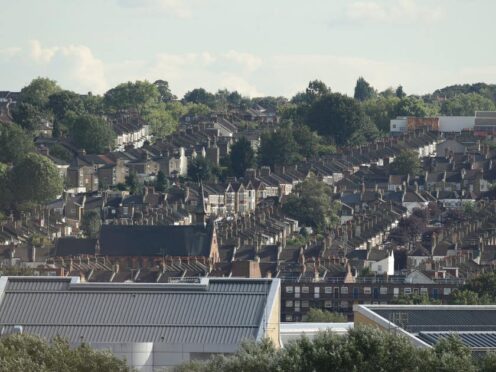
The average UK house price fell by an estimated 0.6% in the year to January 2024, according to an index.
This took the average price of a home in the UK to £282,000, which was £2,000 lower than 12 months earlier.
It followed a decrease of 2.2% in the 12 months to December 2023, the Office for National Statistics (ONS) said.

In the 12 months to January 2024, average house prices decreased in England to £299,000 (down by 1.5%), decreased in Wales to £213,000 (falling by 0.8%), and increased in Scotland to £190,000 (up by 4.8%).
Average house prices increased by 1.4% to £178,000 in the year to the fourth quarter of 2023 in Northern Ireland.
Within the English regions, annual house price inflation was highest in the North West, where prices increased by 1.0% in the 12 months to January.
London was the English region with the lowest house price annual inflation, with prices falling by 3.9% in the 12 months to January.
Across the UK, average private rents increased by 9.0% in the 12 months to February 2024, the ONS said, representing the strongest annual growth since UK records started in January 2015.

The average private rent in Britain was £1,238 in February, which was £102 higher than 12 months earlier.
Across Britain, the average monthly private rent in February was highest in Kensington and Chelsea, London (£3,248) and lowest in Dumfries and Galloway, Scotland (£472).
Excluding London, the local area with the highest average private rent in February was the city of Bristol (£1,734).
The figures were released as ONS data showed that inflation eased back by more than expected in February, boosting hopes that a cut in interest rates could be on the cards within months.
Consumer Prices Index (CPI) inflation fell to 3.4% in February, down from 4% in January.
Experts expect inflation is now likely to fall back below the Bank of England’s 2% target in April or May.

Andrew Montlake, managing director of Coreco mortgage brokers, said of the inflation figure: “It should relieve some pressures on swap rates which will see lenders start to reduce mortgage rates once more.”
Matt Smith, Rightmove’s mortgage expert, said of the inflation figure: “Today’s news is positive, and every day is one step closer to when we might see the first base rate reduction, and mortgage rates are likely to reduce before this.
“I don’t think this will change the course of the Bank of England’s decision on the base rate tomorrow, but I expect both the Bank and home movers will have some renewed optimism for the direction the economy and mortgage rates are heading in after today.”
David Hollingworth, associate director at broker L&C Mortgages, said: “The expected fall in the rate of inflation should mean that mortgage borrowers can rest easy and today’s news shouldn’t result in any big market swings.
“Fixed (mortgage) rates have been nudging back up in the last month after rates dropped sharply in the early part of the year.”
Verona Frankish, chief executive of Yopa, said: “With this morning’s inflation numbers coming in slightly better than expected, all eyes will be fixed on the Bank of England this week in anticipation of a base rate reduction.
“While we expect these hopes may be a tad premature with respect to this week’s decision, it’s seemingly a matter of when, not if, a cut does materialise.
“When it does, it’s likely to act as a shot in the arm to the UK property market, bringing further stability, boosting buyer sentiment and increasing both transaction levels and house prices as a result.”
Tomer Aboody, director of property lender MT Finance, said: “Increased activity in the market is likely in coming months with inflation once again falling and a reduction in interest rates potentially on the way.”
Nicky Stevenson, managing director at estate agent group Fine & Country, said: “Stock levels have been increasing, and the market is becoming much more balanced.
“However, pricing sensibly remains important, particularly for sellers who are pinning hopes on a quick move.”
Nick Leeming, chairman of estate agent Jackson-Stops, said: “Across the Jackson-Stops network in February we saw an uplift month-on-month in appraisals, listings and exchanges, as well as a consistent number of prospective buyer inquiries year-on-year.”
Nathan Emerson, chief executive of property professionals’ body Propertymark, said: “We are now entering spring, which traditionally is one of the busiest times of the year for the housing market.”
Rodrigo Conde Puentes, vice president, senior analyst at Moody’s Ratings said: “Despite housing market correction risks remaining high in the UK, we are now forecasting only a minor nominal decline (minus 1%) in 2024 as inflation slows down, the labour market remains robust and the interest rates stabilise.
“We expect the recovery of house prices to begin in the second half of the year.”

Enjoy the convenience of having The Sunday Post delivered as a digital ePaper straight to your smartphone, tablet or computer.
Subscribe for only £5.49 a month and enjoy all the benefits of the printed paper as a digital replica.
Subscribe